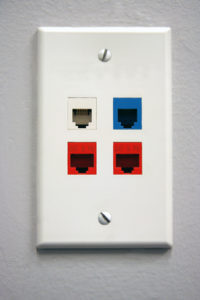 If you’re interested in security, privacy, and uber-fast speeds, you should know that a wired home network offers the best performance and reliability. Wired networks allow for smoother streaming and faster downloads—and that’s key given how much of our entertainment we get online these days. It’s also fair to be concerned about security over wireless networks. Cat5 cabling solves all of that.
If you’re interested in security, privacy, and uber-fast speeds, you should know that a wired home network offers the best performance and reliability. Wired networks allow for smoother streaming and faster downloads—and that’s key given how much of our entertainment we get online these days. It’s also fair to be concerned about security over wireless networks. Cat5 cabling solves all of that.
Home Network Wiring with Cat5 Cabling
Cat5 is short for Category 5 and it’s the the standard in Ethernet networking. Even as technologies change in the long term, Cat5 cabling will provide the infrastructure you need to handle maximum internet speeds. A residential electrician can wire Cat5 cables to every room in the house where you want an internet connection. That means never dealing with a router or getting slower speeds because of which room you’re in.
If you’re very comfortable with cable wiring and the work involved in running cables to new rooms of the house, you can try DIY home networking. Otherwise, figure out what you want and where, then call the local electrician to make it all happen.
Assess Your Needs and Plan
Whether you’re having an expert electrician do the wiring or trying it yourself, your first step will be to decide where you want your Cat5 cabling to run. Consider:
- which rooms and which walls should have cable jacks
- number of ports at each outlet
- where the distribution center should be
- where to run Cat5 cabling through (attic, basement, etc.)
- speed (looking forward, 100MB is preferable to 10MB, but 1GB is available)
DIY Home Wiring with Cat5 Cabling
If you enjoy involved DIY projects, home network wiring might intrigue you. You need some tools beyond screwdrivers and a drill, such as a hole saw and an Ethernet crimping tool. You also need to buy the cables as well as wall plates and other accessories. Of course, even if you are hiring a local electrician to do everything you might these materials are often supplied by them.
Running the Cat5 cabling through the walls is the most difficult part. You need to know how to gain access. Drilling up from the basement or down from the attic may be easiest. Pulling the wire through can also be difficult and tedious.
When you have the Cat5 cabling to your desired locations, you need to trim the cable ’s sheath to reveal some of the internal wires. This is so you can arrange the wires in the right color order and cover with the plug that goes into an Ethernet port. The last step is an easy one: attaching the wall-mounted plates around the jack.
Hiring an Electrician to Wire Your Home with Cat5 Cabling
A professional electrician can handle Cat5 cabling safely and quickly, so unless you’re comfortable and prepared to follow all the specific instructions and begin drilling into your walls, call a pro. Running cabling where existing cable wires are can be relatively easy, but your complete home network will require running cable where there is none currently. This requires strong knowledge of the risks and best practices.
As with any significant DIY project, you need to be careful of hurting yourself or damaging electrical wires, plumbing, load-bearing studs, and anything else you might accidentally drill. The tedious process of running Cat5 cabling and trimming the ends can also be time-consuming and difficult.
Thankfully, it’s a fast and easy project for a experienced professional so it’s definitely efficient to have an electrician do it. You’ll be up and running internet on your home network in no time—and speed is what it’s all about.

